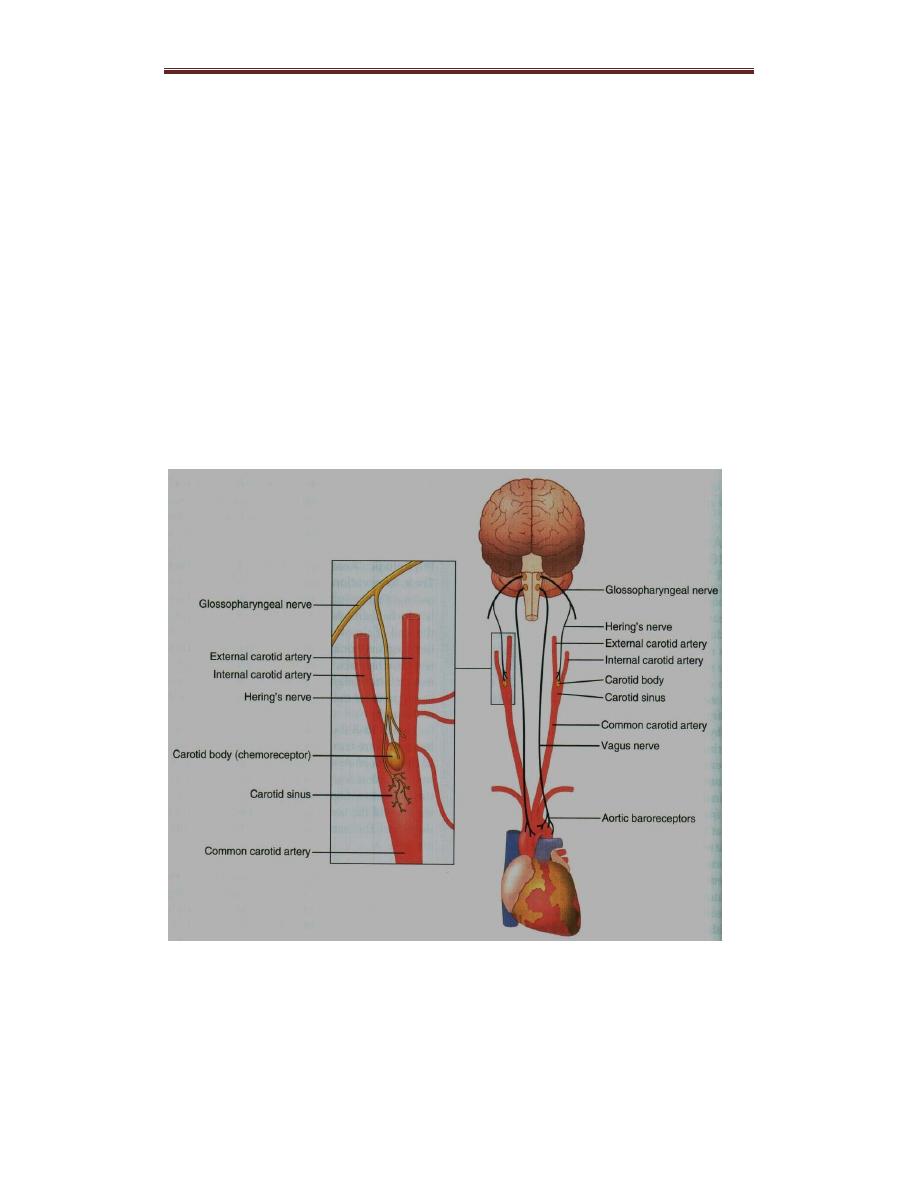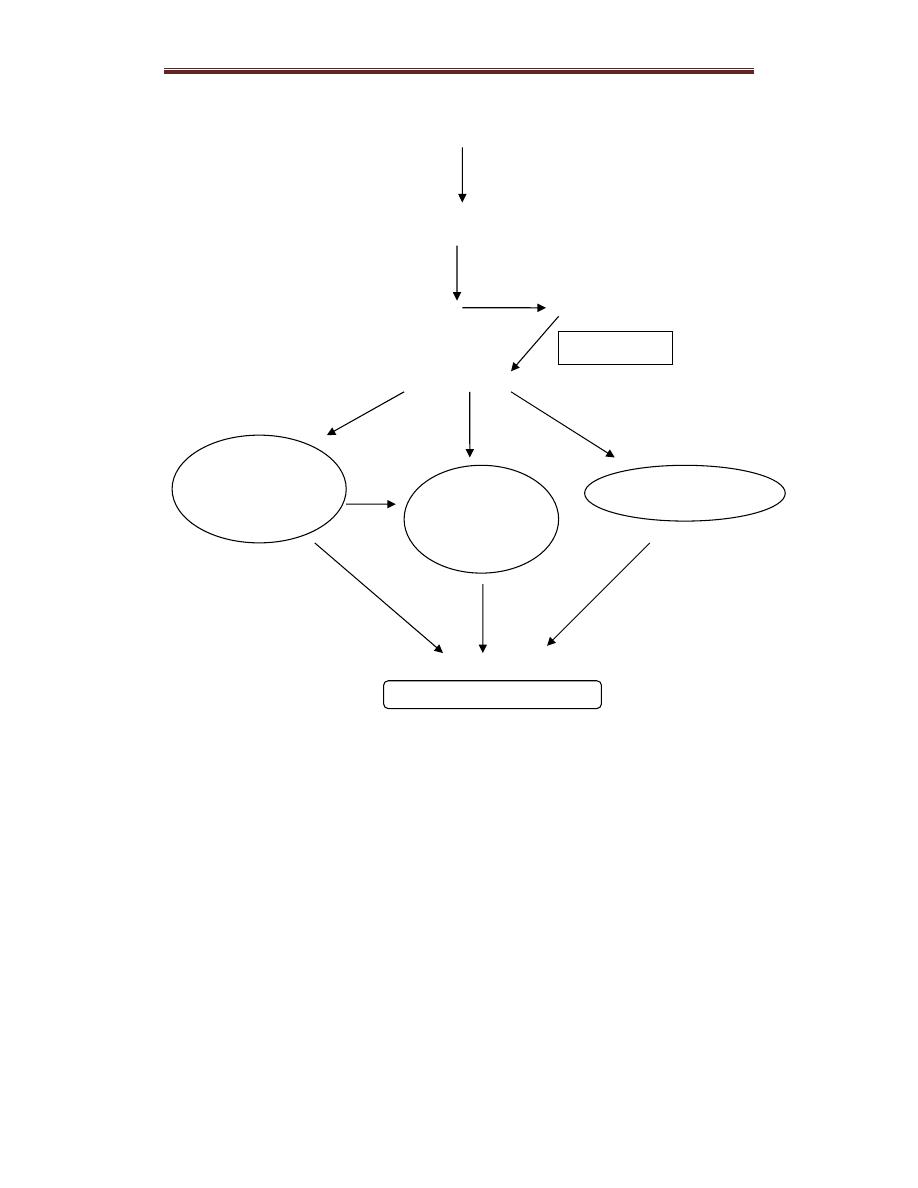
Dr. Zainab F. Hassan Lecture two
1
Regulation of arterial blood pressure:
arterial pressure is regulated by several interacted mechanisms:
-Short term mechanisms.
-Long term mechanisms.
Short term mechanism: these mechanisms act within few
seconds of alteration of BP. They are:
(1) the baroreceptor feedback mechanism: Baroreceptors are
stretch receptors that are extremely abundant in:
(a) the wall of each internal carotid artery slightly above the
carotid bifurcation, an area known as the carotid sinus.
(b) the wall of the aortic arch.
signals from the “carotid baroreceptors” are transmitted through
glossopharyngeal nerves to the medulla. Signals from
the“aortic baroreceptors” in the arch of the aorta are transmitted
through the vagus nerves also to the medulla. When arterial BP
increases cause stimulation of baroreceptors ,so signals
transmitted to the medulla, secondary signals inhibit the
vasoconstrictor center of the medulla and stimulate cardiac
inhibitory center(CIC) and vasodilator center(VDC). The net
effects are (1) vasodilatation of the veins and arterioles . (2)
decreased heart rate and strength of heart contraction.
Therefore, excitation of the baroreceptors by high pressure in
the arteries reflexly causes the arterial pressure to decrease
because of both a decrease in peripheral resistance and a
decrease in cardiac output. Conversely, low pressure has
opposite effects by inhibition of baroreceptors causing the
pressure to- rise back toward the normal.Figure-2.

Dr. Zainab F. Hassan Lecture two
2
Summery
↑ arterial pressure → ↑ stretch → ↑ afferent baroreceptor
firing → ↓ efferent sympathetic firing and ↑ efferent
parasympathetic firing →
o
vasodilitations
o
↓ HR
o
↓ contractility
o
↓BP
Figure (2): The baroreceptor system for controlling arterial
pressure. (Hall, 2016).

Dr. Zainab F. Hassan Lecture two
3
(2)the chemoreceptor mechanism: The chemoreceptors are
chemosensitive cells to oxygen lack, carbon dioxide excess, and
hydrogen ion excess. They are located in several small
chemoreceptor organs (two carotid bodies, one of which lies in
the bifurcation of each common carotid artery, and aortic bodies
adjacent to the aorta). The chemoreceptors excite nerve fibers
that pass through Hering nerve (glossopharyngeal nerves ) and
vagus nerve into vasomotor center. Whenever the arterial
pressure falls below a critical level, the chemoreceptors become
stimulated because diminished blood flow causes decreased
oxygen as well as excess buildup of carbon dioxide and
hydrogen ions that are not removed by the slowly flowing
blood. The signals transmitted from the chemoreceptors excite
the vasomotor center, and this elevates the arterial pressure back
toward normal. However, this chemoreceptor reflex is not a
powerful arterial pressure controller until the arterial pressure
falls below 80 mm Hg.
Summery
↓ arterial pressure → ↓O2 +↑CO2 + ↓PH→ ↑ afferent
chemoreceptor firing → ↑ efferent sympathetic firing and
↓ efferent parasympathetic firing →
vasoconstriction
↑ HR
↑ contractility
↑ BP
(3) the central nervous system ischemic mechanism: when
blood flow to the vasomotor center in the lower brain stem
becomes decreased severely enough to cause cerebral
ischemia—the vasoconstrictor and cardioaccelerator neurons in
the vasomotor center respond directly to the ischemia and

Dr. Zainab F. Hassan Lecture two
4
maintain cerebral blood flow. This CNS ischemic response
occur when BP falls below 60mmHg.
-Long term mechanism: involve the renin-angiotensin
system,rennin is synthesized and stored in the juxtaglomerular
cells of the kidney, these cells located in the wall of the afferent
arterioles proximal to the glomeruli. :decreased BP stimulate
secretion of rennin enzyme from kidney this enzyme act on
angiotensinogen (synthesized by the liver) forming angiotensinI
which is converted to angiotensinII by angiotensin converting
enzyme which is occur in the lung .this angiotensinII has potent
vasoconstrictor effect. Angiotensin II has two principal effects
that can elevate arterial pressure. The first of these,
vasoconstriction in many areas of the body, occurs rapidly.
Vasoconstriction occurs intensely in the arterioles so increases
the total peripheral resistance, thereby raising the arterial. The
second principal means by which angiotensin increases the
arterial pressure is to decrease excretion of both salt and water
by the kidneys. This slowly increases the extracellular fluid
volume, which then
increases the arterial pressure during subsequent hours and days.
AngiotensinII that is formed from rennin-angiotensin system
causes the kidney retain both salt and
water in two major ways: (fig-3)
1. AngiotensinII acts directly on the kidneys to cause salt and
water retention.
2. AngiotensinII stimulates the adrenal glands to
secretealdosterone, and the aldosterone in turn increasessalt and
water reabsorption by the kidney tubules.

Dr. Zainab F. Hassan Lecture two
5
Decreased arterial pressure
Renin(kidney)
Angiotensinogen (Blood) Angiotensin I
ACE(lung)
AngiotensinII
Venous blood pressure
The pressure in the venules is about 12-18 mmHg. It fails in
the larger veins to about 5.5 mmHg in the great veins outside the
thorax and 4.5 mmHg (central venous pressure) at their entrance
the thorax. Peripheral venous pressure is affected by gravity.
venous flow is aided by:
-Muscle pump: every time one moves the legs by contraction of
the muscles which compress the veins adjacent to them and this
squeezes the blood out of the veins. the valves in the veins are
ACE(lung
)
Secretion of
aldosterone
from adrenal
Renal
retention of
salt and water
Vasoconstriction
Increase blood pressure

Dr. Zainab F. Hassan Lecture two
6
arranged so that the direction of venous blood flow can be only
toward the heart.
-Thoracic Pump: During inspiration, the intrapleural pressure
falls . This negative pressure causes drop in central venous
pressure during inspiration which increase venous return. When
the diaphragm descends during inspiration, intra-abdominal
pressure rises, and this squeezes blood toward the heart because
backflow into the leg veins is prevented by the venous valves.
central venous pressure: it is the pressure in the right atrium as
Blood from all the systemic veins flows into the right atrium of
the heart; Right atrial pressure is regulated by a balance between
(1) the ability of the heart to pump blood outof the right atrium
and ventricle into the lungs . (2)the tendency for blood to flow
from the peripheral veins into the right atrium. If the right heart
is pumping strongly, the right atrial pressure decreases.
Conversely, weakness of the heart elevates the right atrial
pressure. Also, any effect that causes rapid inflow of blood into
the right atrium from the peripheral veins elevates the right atrial
pressure.
